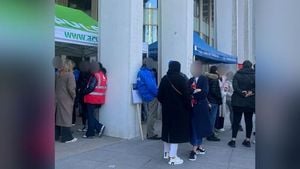Hundreds of Thousands of Palestinians Flee After Israel Seizes Rafah as Part of New 'Security Zone'
Newly Announced 'Security Zone' Includes Some of Gaza's Last Agricultural Land, Critical Water Infrastructure
On Thursday, April 3, 2025, hundreds of thousands of fleeing Gazans sought shelter in one of the biggest mass displacements of the ongoing war, as Israeli forces advanced into the ruins of the city of Rafah, part of a newly announced "security zone" they intend to seize. Just a day before, Israeli forces declared their intention to capture large swaths of the crowded enclave, prompting widespread panic and chaos among the local population.
According to Gaza's Health Ministry, at least 97 people were reported killed in Israeli strikes in the past 24 hours, including at least 20 in an airstrike around dawn in the Shuja'iyya suburb of Gaza City on April 2, 2025. The situation escalated further on Thursday when an Israeli airstrike killed at least 27 Palestinians, including women and children, inside a school building that served as a shelter for displaced families in Gaza City. Medics reported that three missiles slammed into the Dar Al-Arqam school building in the Tuffah neighborhood, highlighting the dire conditions faced by civilians.
A father of seven, who fled from Rafah to neighboring Khan Younis, described the devastation, stating, "Rafah is gone, it is being wiped out. They are knocking down what is left standing of houses and property." His sentiments echoed those of many who have lost everything, as Adel Abu Fakher lamented while checking the damage to his tent, "Is anything left for us? There's nothing left for us. We're being killed while asleep." This assault to capture Rafah represents a significant escalation in the conflict, which Israel resumed last month after effectively abandoning a ceasefire that had been in place since January 2025.
Israel has not clarified its long-term objectives for the security zone its troops are now seizing. Prime Minister Benjamin Netanyahu referred to the area as the "Morag Axis," referencing an abandoned former Israeli settlement located between Rafah and Khan Younis. The fear among Gazans is that Israel's intent is to depopulate these areas indefinitely, leaving many hundreds of thousands permanently homeless in one of the world's most densely populated and impoverished territories.
The security zone includes some of Gaza's last agricultural land and critical water infrastructure. Since the first phase of the ceasefire expired at the start of March 2025, Israel has imposed a total blockade on all goods reaching Gaza's 2.3 million residents, leading to what international organizations describe as a humanitarian catastrophe after weeks of relative calm.
Israel's stated goal since the onset of the war has been the destruction of the Hamas militant group, which has governed Gaza for nearly two decades. However, despite the ongoing military campaign, no efforts have been made to establish an alternative administration. During the ceasefire, Hamas-led police returned to the streets, and fighters still hold 59 dead and living hostages, which Israel insists must be released to extend the truce. Hamas has stated it will only free them under a deal that ends the war.
The conflict began with a Hamas-led attack on Israeli communities on October 7, 2023, resulting in the deaths of 1,200 people and the abduction of more than 250 hostages, according to Israeli tallies. In retaliation, Israel's campaign has so far claimed the lives of over 50,000 Palestinians, as reported by Gaza health authorities.
Interestingly, despite the ongoing violence, Israeli leaders have noted signs of protest in Gaza against Hamas, with hundreds of people demonstrating in northern Gaza's Beit Lahiya on Wednesday, April 2, 2025, opposing the war and demanding that Hamas relinquish power. Hamas, in turn, has labeled the protesters as collaborators and accused Israel of orchestrating the demonstrations.
Most residents of Rafah have complied with Israel's order to evacuate as Israeli strikes toppled buildings in the area. However, a strike on the main road between Khan Younis and Rafah halted most movement between the two cities. Residents reported that movement of people and traffic along the western coastal road near Morag was also severely restricted due to bombardment. One resident, Basem, expressed the despair felt by many: "Others stayed because they don't know where to go, or got fed up of being displaced several times. We are afraid they might be killed or at best detained." The situation has led to empty markets and soaring prices for basic necessities under Israel's total blockade of food, medicine, and fuel.
In a further grim update, the Gaza Ministry of Health announced on Thursday that 100 martyrs, including three recovered, and 138 injured people arrived at hospitals in the Gaza Strip in the past 24 hours. Since March 18, 2025, the death toll has reached 1,163 martyrs and 2,735 injured, with many victims still trapped under the rubble as rescue efforts continue.
The Palestinian Health Ministry, which operates from the Israeli-occupied West Bank but has nominal authority over hospitals in Gaza, warned that the entire healthcare system in Gaza is at risk of collapse. As the conflict continues to escalate, the humanitarian situation grows increasingly dire, with the international community watching closely and calling for urgent intervention.




